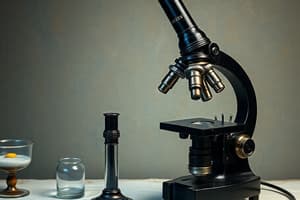Podcast
Questions and Answers
What is the structure indicated by the number 1?
What is the structure indicated by the number 1?
Ocular lens
What is the structure indicated by the number 2?
What is the structure indicated by the number 2?
Revolving nosepiece
What is the structure indicated by the number 3?
What is the structure indicated by the number 3?
Objective lenses
What is the structure indicated by the number 4?
What is the structure indicated by the number 4?
What is the structure indicated by the number 5?
What is the structure indicated by the number 5?
What is the structure indicated by the number 6?
What is the structure indicated by the number 6?
What is the structure indicated by the number 7?
What is the structure indicated by the number 7?
What is the structure indicated by the number 8?
What is the structure indicated by the number 8?
What is the structure indicated by the number 9?
What is the structure indicated by the number 9?
What is the structure indicated by the number 10?
What is the structure indicated by the number 10?
What is the structure indicated by the number 11?
What is the structure indicated by the number 11?
What is the structure indicated by the number 12?
What is the structure indicated by the number 12?
What is the structure indicated by the number 13?
What is the structure indicated by the number 13?
Which power of magnification should one always start off on?
Which power of magnification should one always start off on?
How does one calculate the total magnification of an object?
How does one calculate the total magnification of an object?
What direction does an object move if you move the slide to the left?
What direction does an object move if you move the slide to the left?
What direction does an object move if you move the slide away from you?
What direction does an object move if you move the slide away from you?
Which adjustment, coarse or fine, do you use first?
Which adjustment, coarse or fine, do you use first?
What regulates the amount of light passing through the specimen?
What regulates the amount of light passing through the specimen?
When one focuses the microscope on low power and then shifts into high power, the object is fairly in focus. What is this called?
When one focuses the microscope on low power and then shifts into high power, the object is fairly in focus. What is this called?
What is the total magnification when calculated?
What is the total magnification when calculated?
What type of microscope is used in most science labs?
What type of microscope is used in most science labs?
How does one properly carry a microscope?
How does one properly carry a microscope?
What is the rotating structure that the objectives are attached to on a microscope?
What is the rotating structure that the objectives are attached to on a microscope?
Flashcards are hidden until you start studying
Study Notes
Microscope Components
- Ocular Lens: The eyepiece used for viewing specimens directly.
- Revolving Nosepiece: A rotating component that holds and allows users to switch between different objective lenses.
- Objective Lenses: These lenses provide varying levels of magnification for the specimen being observed.
- Slide Clips: Metal clips that hold the slide in place on the stage for stability during observation.
- Stage: The flat platform where the slide is placed for examination under the microscope.
- Iris Diaphragm Lever: Adjusts the amount of light that passes through the specimen, enhancing visibility.
- Condenser: Focuses light onto the specimen to improve the clarity of the observation.
- Base: The bottom part that supports the microscope and contains the light source.
- Arm: The curved structure that connects the base to the head of the microscope and provides support during movement.
- Coarse Adjustment Knob: Used for making large adjustments to focus on the specimen.
- Fine Adjustment Knob: Used for making small, precise adjustments to sharpen the image after coarse focusing.
- Stage Manipulator Knobs: Controls the position of the slide, allowing for easy navigation of the specimen.
Microscope Operation
- Light Intensity Control: Regulates the brightness of the light source, allowing for optimal viewing of the specimen.
- Low Power: Always start observations at low power magnification for ease of finding and focusing on the specimen.
- Total Magnification Calculation: Achieved by multiplying the ocular lens magnification by the objective lens magnification (ocular x objective).
- Slide Movement Direction: If the slide is moved to the left, the object appears to move to the right.
- Slide Movement Direction: If the slide is moved away from the user, the object appears to move toward the user.
- Coarse Adjustment First: The coarse adjustment knob is used first to locate the specimen before making fine adjustments.
- Iris Diaphragm Function: Regulates the amount of light to enhance visibility of the specimen.
- Parfocal Design: This feature allows for the microscope to remain in focus when switching from low to high power.
Microscope Types and Handling
- Total Magnification Overview: Reiterated as ocular x objective.
- Compound Light Microscope: This is the most commonly used microscope type in science labs.
- Proper Carrying Technique: Always carry the microscope by holding it securely by the arm and base to prevent accidents.
- Revolving Nosepiece Functionality: Houses and rotates the objective lenses for magnification changes.
Studying That Suits You
Use AI to generate personalized quizzes and flashcards to suit your learning preferences.




